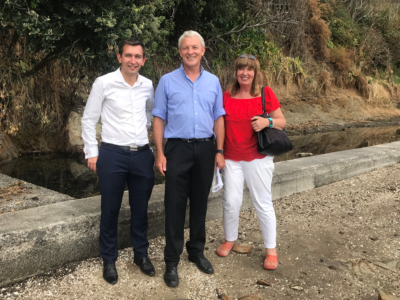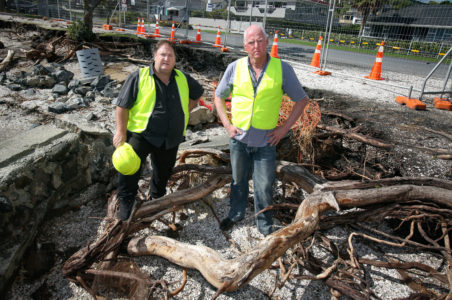
As the storm that battered the country earlier this year becomes a distant memory, the focus is turning to how to prepare for the future.
Local beaches were battered in the storm, which caused severe flooding, power cuts and widespread debris.
Auckland Mayor Phil Goff visited Mellons Bay last Friday on the first of his tour of local beaches to survey the damage and speak with residents and Local Board members about erosion concerns and preventative measures for the future.
Goff said some local beaches, including Cockle Bay, Little Bucklands Beach, Big Bucklands Beach and Eastern Beach, had been identified as areas of urgency and council staff were acting quickly before the next king tide hit.
“Sometimes we worry we put the red tape out and it stays there for months and in this case we want to move as quickly as we can [and] it is going to impose another cost you don’t budget for but you do need to when it comes up,” he said.
Speaking alongside Goff, Auckland Council manager coastal and geotechnical services Paul Klinac said the swell that hit during the king tide was of a “reasonable magnitude” and created a water level approximately a metre above the average high tide level.
Klinac said work was being done with Howick Local Board to explore options for long-term treatment for affected beaches – one of which was to explore the option of extending the seawall at Cockle Bay beach.
“We met contractors on site and the short term response [is] to put geotextile cloth in where you’ve got pronounced scour in and around the Pohutukawa tree [and] to put some rock in front of that geotextile and come back with contractors in approximately three weeks time and look to extend that sea wall.”
He said it would be important to address wave reflection which could be dealt with by a combination of responses.
“It may be that we look to install some rock revetment in front of the structure to dissipate some wave energy, [and] that might be in combination with a groyne structure to better control that wave energy that’s coming in.”
Klinac said an extension of the sea wall at Cockle Bay would “terminate in a way that will obviate some of those end effects and provide protection to the Pohutukawa that are there currently”.
“We’ve worked closely with council arborists and they have confirmed that the trees [at Cockle Bay] are not beyond saving.

“There was mixed messages there that one tree might have to come out – that’s not the case.”
Howick Local Board member Garry Boles, who holds the parks portfolio, says an urgent meeting was held following the storm to discuss restoration plans for beaches that were already underway and would now be pushed through quicker.
He said Bucklands Beach had suffered a large washout at one area on The Parade that has been addressed by Auckland Council which put in sandbags and is looking at a long-term vision.
Boles said Mellons Bay would need immediate refurbishment work due to a large section being scoured out during the storm and Council and local board members were looking to see what would need to be done long-term.
The Half Moon Bay boat ramp, which was severely damaged in the storm, was expected to cost around $100,000 to repair, said Boles, and it would be another six to 10 weeks before the floating pontoons which were removed after the storm for repair and refurbishment would be returned.
Boles said it was a ‘perfect storm’ of events, but he said there was no need to worry about the next lot of high tides unless there was another storm.
“It wasn’t [just] the wet weather, it was to do with the tide. We had an extra 300-400mm of water rising, the king tide, wind from the direction that hurts us the most [a nor’easter] – all planets were aligned.”
Mr Goff said it could have been much worse.
“Despite the perfect storm of the king tide coinciding with the storm it could have been much worse than that.”
“It wasn’t as dramatically bad, for example, as the storm we had back in March when we had that huge degree of flooding but it’s still concerning to residents when you’ve just watched the coastal fringe eating into the reserve area and the potential damage to the beach and the facilities on it.
Speaking to the Times at Cockle Bay last week, Boles and Howick Local Board chairman David Collings said the storm is a good reminder for locals to check how prepared they would be if a more severe storm struck.
“It’s a good time to look at how prepared we are – do we have enough reserves?” said Boles.
“[This time] a lot of people were fine but if it was a little bit worse a lot of people wouldn’t have been fine and we just have to keep in mind how your emergency kit is at home.”









